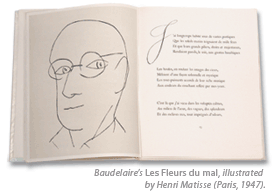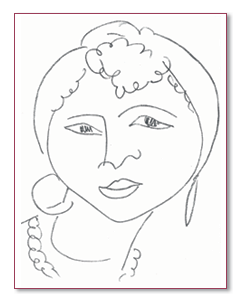
 |
Special Collections Acquires Rare Matisse Edition
The UCI Libraries have acquired a landmark title in the history of 20th-century book illustration: Charles Baudelaire's Les Fleurs du mal, with lithographs by the great Impressionist artist Henri Matisse. Professor Emeritus of French Judd Hubert explains the significance of Matisse's illustrations.
![]()
Baudelaire's Les Fleurs du mal has been illustrated over the years by a variety of major artists, including Emile Bernard, Charles Despiau, Jacob Epstein, Gustave Rodin, Georges Rouault, and Pierre-Yes Trémois. Each interpreted selected poems more or less faithfully. Matisse took a different approach in the 1947 edition published by La Bibliothèque Française, of which UCI now owns the only copy in the University of California (320 copies were printed).
 Instead of attempting to bring out the narrative qualities of the texts he chose, Matisse drew 33 portraits, including one of himself, one of Baudelaire, three of young men, and 29 of women. Instead of referencing the readily-available likenesses of women associated with Baudelaire's life, Matisse relied on models--one of them a mulatta--who also figure in his paintings and engravings. The lucid Matisse did not indulge in the biographical fallacies of the literary critics of his day who attempted to understand Baudelaire by associating each poem with the woman who may have inspired it. Thus, Matisse's gallery of facial portraits provides a reactive accompaniment rather than a mimetic rendition of selected poems.
Instead of attempting to bring out the narrative qualities of the texts he chose, Matisse drew 33 portraits, including one of himself, one of Baudelaire, three of young men, and 29 of women. Instead of referencing the readily-available likenesses of women associated with Baudelaire's life, Matisse relied on models--one of them a mulatta--who also figure in his paintings and engravings. The lucid Matisse did not indulge in the biographical fallacies of the literary critics of his day who attempted to understand Baudelaire by associating each poem with the woman who may have inspired it. Thus, Matisse's gallery of facial portraits provides a reactive accompaniment rather than a mimetic rendition of selected poems.
 His well-known interest in the expressions and gestures of women, real or imaginary, suffices to explain his approach. In this respect, the Matisse illustrations of Les Fleurs du mal have much in common with his numerous etchings and lithographs of attractive women. Nonetheless, each of the portraits does take meaning into account in a rather special manner by its position, pose, or expression.
His well-known interest in the expressions and gestures of women, real or imaginary, suffices to explain his approach. In this respect, the Matisse illustrations of Les Fleurs du mal have much in common with his numerous etchings and lithographs of attractive women. Nonetheless, each of the portraits does take meaning into account in a rather special manner by its position, pose, or expression.
The mulatta model strikes a submissively voluptuous pose in poems such as "Parfum exotique," but seen in profile in "Sed non satiata," she appears sinister and dominant. By her imperial gaze and neat appearance, the most youthful of the female models truly impersonates "La Beauté," while her kittenish but predatory expression perfectly suits "Le Chat." By his pose for "Bénédiction," the young male model expresses stress, whereas his upright position in "L'Homme et la mer" suggests manly strength.
The volume is available for use in Special Collections and Archives in Langson Library (spcoll@uci.edu or x47227).

|
|